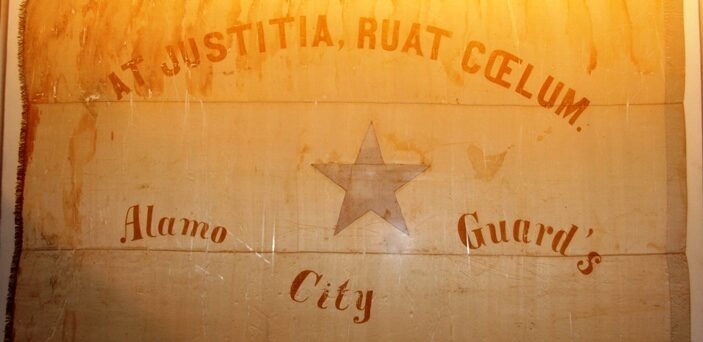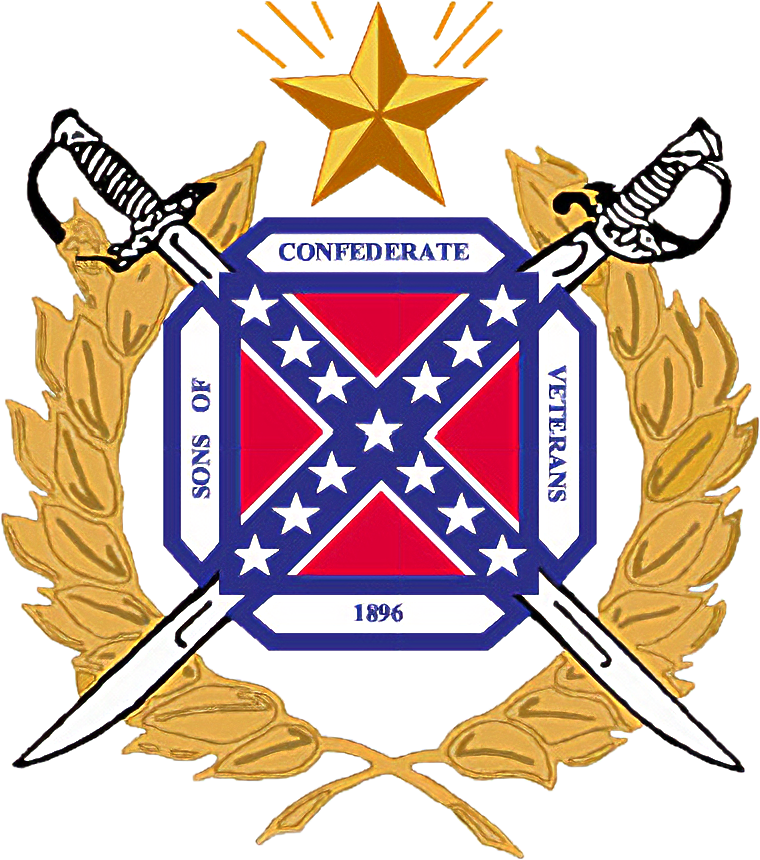Texas Flags
TEXAS DIVISION
SONS OF CONFEDERATE VETERANS
Ready To Join?

The flag of the Alamo City Guards. Donated by Mrs. O. M. Burt; restoration assisted by the Sons of Confederate Veterans. Image courtesy of Ernesto Rodriguez, Alamo assistant curator. The flag described by Edgar was donated to the Alamo by his daughter in the early twentieth century and restored in 2006 by Textile Preservation Associations. The field was always thought to have originally been blue; however, conservators determined it had actually been cream colored with a salmon-colored star in the center. The Latin motto on the flag translates to Let justice be done though the heavens should fall.

This large (8-1/2′ x 12′) flag is typical of the type of flag used in civil or government service. It is a slight variant from the normal pattern in that one of the stars is centrally located.
Most 1st National flags made in Texas featured this unique star. This particular flag lies folded in a box in the Texas State Archives and funds are needed for its conservation.

This Texas Flag was carried by the 1st Texas Infantry into the Cornfield at Sharpsburg. After 20 minutes of savage fighting, 82.3% of the regiment was dead or wounded, the highest casualty rate suffered by any unit during the war. After seven color bearers were killed carrying the flag, it was found on the field after the battle, surrounded by dead Texans. Returned to Texas by the Federal Government in 1905, it is currently undergoing conservation.

This flag was flown by Company G, of the 16th Texas. It is not known whether the regiment was the 16th Texas Cavalry or the 16th Texas Infantry Regiment. Both units served in Walker’s Texas Division. Its lack of a white border along the cross is
typical of Trans-Mississippi Battle Flag Variants.

This unique Battle Flag features a black cross superimposed over the Battle Flag. The significance of this feature is not known. This flag lies folded up in a box in the Archives, waiting conservation. Due to its delicate nature, it can only be handled by a skilled conservationist without damaging it.

This Second National Pattern Flag was used by the 33rd Texas Cavalry, which served primarily in South Texas along the Rio Grande River. One of its officers was Santos Benevides, who became the unit’s colonel and was the highest ranking Hispanic officer to attain a field command in the Confederate service.

The Secession Flag of South Carolina is one of several flags of other Confederate States that have found its way to the Texas State Library and Archives. The crescent moon was a symbol popular in the South, and especially in the states of South Carolina and Louisiana.

This flag was found with the First Texas Lone Star Flag in the cornfield at Sharpsburg. It features a tear that was repaired with a woven lock of hair from a Union Zouave killed during the Battle of Second Manassas. It is made of cotton and was designed to replace previous editions made of silk that were too fragile for field use. This flag is currently undergoing conservation.

This flag was probably used by elements of Walker’s Texas Division. It features the reversed colors which were the distinctive features of the battle flag designed by Lt. General Richard Taylor. It displays battle honors for the battles of Mansfield and Pleasant Hill, in which the Division played a significant role. This large (6′ x 6′) silk flag is currently undergoing conservation.

There is little information available about this flag. The flag was made of expensive materials, such as silk and a stiff wire fringe. The fringe may have been gilt or old in color. Like most Texas flags of the era, the star is tilted on its axis.

This unique flag features a large red star, with 11 smaller stars contained within its points. In addition, there is a shield in the white bar. The shield features a yellow star and word “TEXAS.” It is unknown which Texas units utilized this Battle Flag. This flag is currently undergoing conservation.

This Battle Flag was the last flag used by the 1st Texas Infantry. It was captured at Appomattox, Virginia on April 8, 1865, one day before the surrender of General Lee. It is the final variant of the Army of Northern Virginia Pattern, with the white border on all four sides of the flag. Returned to Texas in 1905, it is currently undergoing conservation.

This Flag was used by the 6th Texas Infantry and 15th Texas Cavalry (Dismounted), which served in Granbury’s Texas Brigade of the Army of Tennessee. This flag is a variant of the Hardee Pattern Battle Flags used by the division of Irish-born General Patrick Cleburne throughout the war. Inside the white disc is a large red star, around which is spelled “TEXAS.” This flag is currently undergoing conservation.
Photos are courtesy of the Archives Division, Texas State Library. Special thanks to the late Mel Wheat of the William H. L. Wells Camp of Plano, Texas, who provided many of the photos used for this page.
Got Questions?
Got questions about the Sons of Confederate Veterans? We can answer any question you could possibly have.

